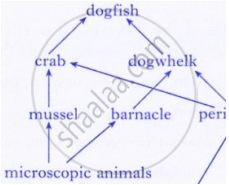Advertisements
Advertisements
Question
What is meant by a primary consumer, secondary consumer and a tertiary consumer? Give one example of each.
Solution
Herbivores that feed on plants are called primary consumers. Example: Insects.
Small carnivores that feed on other animals, especially herbivores, are called secondary consumers. Example: Frogs.
Large carnivores that feed on other animals, especially secondary consumers, are called tertiary consumers. Example: Birds.
Insects → Frogs → Birds
(Primary consumers) (Secondary consumers) (Tertiary consumers)
APPEARS IN
RELATED QUESTIONS
What is the difference between the food habits of organisms belonging to the first and the third trophic levels? Give one example each of the organisms belonging to these two trophic levels.
Consider the food chain :
Grass → Deer → Lion
What will happen if all the lions are removed from the above food chain?
Which of the following represents a possible food chain found in a pond :
| Primary producers |
Primary consumers | Secondary consumers |
| (a) green algae | fish | mosquito larvae |
| (b) fish | green algae | mosquito larvae |
| (c) mosquito larvae | fish | green algae |
| (d) green algae | mosquito larvae | fish |
The decomposers in an ecosystem ______.
With the help of a food chain, explain how biological magnification of harmful chemicals can occur.
What percentage of sun's energy falling on the leaves of green plants is utilised by the plants in the process of photosynthesis and stored as chemical energy of food?
(a) 99 per cent
(b) 10 per cent
(c) 1 per cent
(d) 20 per cent
Primary consumers that eat plants are called _______.
Observe the food web and answer the questions given below:

Why do all food chains start with plants?
The sequence of who eats whom in an ecosystem is called as ______.
Animals that eat both plants and animals are called as Carnivores.
